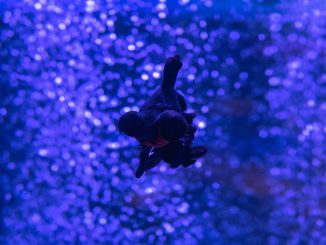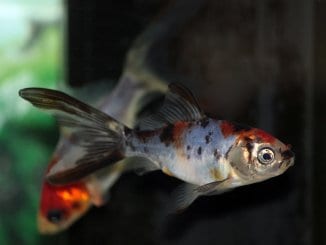
The veiltail goldfish is a rare freshwater fish that is a part of the Cyprinidae family. They are of the same family as common goldfish and fancy goldfish.
Veiltail goldfish are famous for their delicate fins, bright colors, and gracious movement. These fish are rare because they are difficult to breed.
Aquarists value veiltails for their beautiful shape and vibrant colors. Veiltail goldfish are hard to care for because they require precise water temperatures and tank decorations. They’re also quite expensive.
TABLE OF CONTENTS
Veiltail Goldfish Facts & Overview

| Category | Rating |
| Care Level: | Moderate/Hard |
| Temperament: | Peaceful |
| Color: | Orange/Red/Metallic |
| Lifespan: | 10-15 years |
| Size: | 7 inches |
| Diet: | Omnivore |
| Family: | Cyprinidae |
| Minimum Tank Size: | 20 gallons |
| Tank Setup: | Freshwater, plants, no decorations with sharp points |
| Compatibility: | Other goldfish, peaceful species |
The veiltail goldfish is known by its scientific name Carassius auratus auratus. It is a part of the Cyprinidae family and was bred artificially in the late 19th century in America. Veiltails are fancy goldfish that are popular for their appearance.
Veiltail goldfish cannot be found in the wild.
These fish faced extinction in the 20th century. A group of aquarium enthusiasts revived the breed and continued to preserve the veiltails.
Veiltails have a long lifespan when cared for correctly. They can live between 10 and 20 years. The veiltail goldfish is a freshwater fish that needs a lot of tank space to swim freely. Their tails and fins are delicate, so keeping sharp accessories and plants away from the fish is vital.
Veiltails are uncommon and hard to find in pet stores. These fish are expensive and difficult to breed compared to other goldfish species.
Appearance & Behavior

Veiltails have thin and translucent tails and fins. They are brightly colored fish and come in shades of red and orange. Some fish will display patches of white or dark colors on their bodies and metallic scales.
Veiltail goldfish have egg-shaped bodies with wide heads and round stomachs. Their dorsal fins are typically erect, and their tails can be split in two.
The adult veiltail goldfish measures between six and seven inches long. The fish’s fins are three inches long, whereas the veiltail’s body will grow up to 4 inches long.
Male and female veiltails look similar, and telling them apart is challenging. Male fish are smaller than females. Female fish have round bodies, whereas male fish are slim. Males develop a pair of pectoral fins and small light-colored growths on their gills when the fish are ready to breed. Female fish that are ready to breed have swollen bellies.
Typical Behavior
The veiltail goldfish is a peaceful fish that gets on well with other non-aggressive species. It is a great community fish and a good addition to a community tank.
Veiltails are not very fast swimmers. They feed on food that falls to the bottom of the tank. Veiltails will move the substrate in search of food, making the water look muddy.
These fish require a balanced day-and-night cycle. They are active during the day and enjoy natural sunlight. Keep the tank near a window if possible. Feed the fish twice daily with enough food to eat in a minute. Avoid overfeeding the veiltails.
Veiltail Goldfish Care
The veiltail goldfish is difficult to care for. Ensure the fish eat a high-quality diet and have plenty of tank space. Feed the fish pellets, flakes, plants, and animal products. Aquarists should perform regular water changes, keep the water parameters consistent, and perform health checks to make sure the fish stay healthy.
Veiltails are also prone to swim bladder disease, which causes abnormal swimming behaviors and loss of balance. They can also catch common fish diseases like bacterial infections, parasites, and ich. Diseases and infections can occur from poor hygiene in the tank.
Habitat and Tank Requirements

Veiltails are not found in the wild, so looking at their relatives’ natural habitat will help determine the fish’s tank requirements. The veiltail goldfish is related to carp, which are freshwater fish that live in slow-moving rivers in Asia and Europe. These fish live in dark, murky waters.
Veiltails require calm water and cool temperatures matching the carp’s natural habitat. Avoid decorations, plants, and tank accessories that could damage the veiltails delicate fins.
Tank Conditions
The veiltail goldfish is a freshwater fish that tolerates moderate salinity levels in the tank. An appropriate tank size for veiltail goldfish is 20 gallons, but 30 gallons is ideal.
Veiltails prefer cool water temperatures between 65° and 72°F. Never let the temperature get lower than 65°F to avoid complex health problems.
These fish will scavenge for food at the bottom of the tank. Choose a smooth medium-sized gravel substrate to help the fish find food. Fine sand substrate is dangerous as the veiltails will swallow small pieces of the substrate, causing constipation.
Don’t overcrowd the tank. Veiltail goldfish need plenty of swimming space. Avoid artificial plants with hard and sharp leaves, which will tear the fish’s tail and fins.
Water bubblers are not suitable for veiltail goldfish tanks. These fish are slow swimmers, and bubblers make it hard for the veiltails to swim freely. Water filters will help aquarists keep the water clean and hygienic. Invest in a high-quality water filter to make maintaining the tank easier and to prevent disease.
Tank Mates
The veiltail goldfish is compatible with other fancy goldfish and slow-moving, non-aggressive fish. The best tank mates for the veiltail goldfish are the telescope goldfish, celestial goldfish, and the lionhead goldfish.
Veiltail goldfish are peaceful and friendly. These fish are ideal for a community tank setup.
Do not keep veiltail goldfish with aggressive and territorial fish or with fin nippers. Fin nipping fish can damage the veiltail’s delicate fins and tails permanently. Tetras and bettas are not suitable tank mates for veiltail goldfish.
Other goldfish species are also unsuitable for veiltail goldfish tanks. Goldfish are fast swimmers and compete for food, which is not appropriate for veiltail goldfish tanks.
Disease
Veiltail goldfish are susceptible to diseases. Common aquarium issues and goldfish diseases and infections will affect the veiltail goldfish.
Swimming bladder disease is a common veiltail goldfish issue. Swimming bladder disease restricts the fish’s movement, causing them to lose balance. Overchilling causes this disease, so keep the water temperatures stable at all times.
Treat swimming bladder disease early. Abnormal swimming behavior is a sign of swimming bladder disease.
These fish are susceptible to bacterial and fungal infections. Good hygiene and regular water changes prevent bacterial and fungal infections—quarantine new fish before introducing them into a community tank to avoid contamination.
Diet and Feeding
The veiltail goldfish needs a diverse and nutritious diet to thrive. Feed the veiltails a combination of flake foods, small animal foods, and plant-based foods.
Veiltails can suffer from overeating. Fish will eat all of the food in the tank, even if the fish are full. Feed the fish twice per day and for just one minute to avoid overfeeding.
Breeding
Breeding veiltail goldfish is extremely challenging and not recommended for beginner aquarists. Aquarists looking to breed veiltail goldfish need preparation.
Aquarists need a separate breeding tank no smaller than 20 gallons. Fill the aquarium with fresh water with a water temperature of 50°F. Decorate the tank with green plants to prompt spawning.
Once the fish have acclimatized to the cool water, raise the water temperature daily until the tank hits 65°F.
Keep the ambiance calm and feed the fish a nutritious diet of fish flakes and live food. The male will start chasing the female around the tank when the fish are ready to breed.
Spawning can take several days. Females release eggs that are later fertilized by the males. Females can release up to 10,000 eggs.
Fertilized eggs take several days to hatch. Veiltail fry are dark-colored and lighten over time. Their dark complexion camouflages and protects them against predators. Feed the fry a small amount of fry food.
Should You Get a Veiltail Goldfish for Your Aquarium?
Veiltail goldfish come with many care challenges. Enthusiastic aquarists that are up for a challenge will benefit from keeping veiltail goldfish in their tank.
The veiltail goldfish will add vibrance and movement to your tank. They are also great companions for other fancy goldfish.
Keep in mind that these fish require a lot of attention and care. They also need very specific tank conditions to protect them from physical damage and health problems.







Be the first to comment